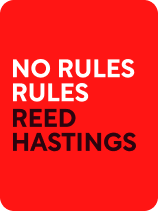

This article is an excerpt from the Shortform book guide to "No Rules Rules" by Reed Hastings. Shortform has the world's best summaries and analyses of books you should be reading.
Like this article? Sign up for a free trial here .
What is an unlimited vacation policy? Does it make employees work more or do they take advantage and disappear for long periods?
Reed Hastings, CEO of Netflix, focuses on work quality over quantity. In keeping with that philosophy, an unlimited vacation policy allowed employees to take off time as they desired as long as they’re getting what they need to do done.
Keep reading for more about the unlimited vacation policy at Netflix, as shared by Reed Hastings in No Rules Rules.
Implementing an Unlimited Vacation Policy
Even before launching Netflix, Hastings believed that the quality of employees’ work mattered more than the quantity of time they spent producing it, especially in creative industries. If a worker produces great work and gets it done in 25 hours instead of 40, her achievement should be celebrated more than that of someone who toils on the clock for 40 hours to achieve the same thing. So when an employee questioned the company’s vacation policy, Hastings decided to get rid of it altogether: Since 2003, Netflix has neither allotted vacation time nor tracked days off. However, Hastings created other parameters to ensure that the unlimited vacation policy created more benefit than harm.
Prevent Employees From Taking Too Much or Not Enough Vacation
Despite the benefits of an unlimited vacation policy, Hastings had to implement the change strategically in order to avoid two potential problems.
Problem #1: Workers take too much vacation. If too many people take off at once, or they leave while their team is pushing to meet a deadline, this could cripple workflow, especially with a small staff (as Netflix had when the policy went into effect).
Solution #1: In the absence of controls, managers must lead with context (we’ll talk more about leading with context in Chapter 9). Managers must give employees enough context to make sound decisions about when to take vacations and for how long. This may include telling employees that:
- They can’t take vacations within two weeks of a deadline.
- No more than one team member can be out at one time.
- They must consider whether their time off will hurt the rest of the team.
- They must give two weeks’ notice for a five-day vacation and a month’s notice for a month-long vacation.
Other companies—including Glassdoor, LinkedIn, and Virgin Management—followed Netflix’s lead and also have an unlimited vacation policy. They found the following guidelines helpful:
- Do everything necessary to achieve your goals.
- Don’t do anything that inhibits others from reaching their goals.
- Make decisions that are in the best interest of the company.
Problem #2: Workers take too little vacation, because they don’t want colleagues to think they’re not carrying their weight. Under normal vacation policies, the threat of losing unused vacation days often motivates employees to take time off if they wouldn’t otherwise.
Solution #2: Leaders must set an example by taking big vacations, talking openly about them, and encouraging employees to do the same. Regardless of what managers say, workers will follow what they do—if they say that everyone should feel free to take plenty of vacation, but they only take a week off all year, employees won’t feel comfortable taking long vacations. Similarly, if the CEO takes five weeks’ vacation but a department head barely takes two, that manager’s team will follow her lead. In other words, all leaders—from the executive suite to the middle managers—must set a good example of work-life balance for their subordinates.
Employee Productivity Increased
Surprisingly, employees don’t take significantly more time off with an unlimited vacation policy than they did under a restricted vacation policy—and the same has been true at several other companies that have also eliminated their vacation policies. Despite little to no change in behavior, employees greatly appreciate the freedom, which boosts morale, productivity, and creativity. Additionally, the policy (or non-policy) brings other significant benefits:
- It gives employees more control over their lives to create a work-life balance, which improves their job satisfaction and performance.
- It makes it easier to attract and retain the industry’s top talent, especially millennials and Gen Z workers who favor less restrictive work settings.
- It cuts the administrative costs of tracking employees’ vacations and days off.
- It sends a message to employees that management trusts them, which inspires them to live up to that trust. After implementing the policy, Hastings noticed subtle ways in which people started taking more responsibility around the office, such as throwing out expired milk in the office kitchen.

———End of Preview———
Like what you just read? Read the rest of the world's best book summary and analysis of Reed Hastings's "No Rules Rules" at Shortform .
Here's what you'll find in our full No Rules Rules summary :
- How Netflix achieved massive success in a short period of time
- The unusual business practices that have helped Netflix sustain its success
- Why Netflix fires adequate employees






